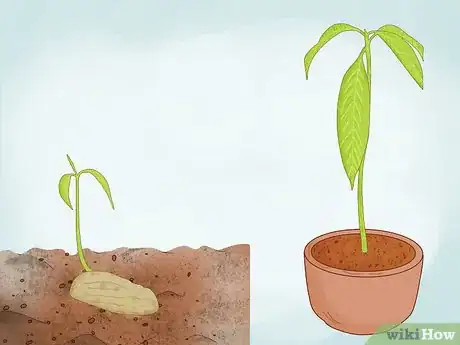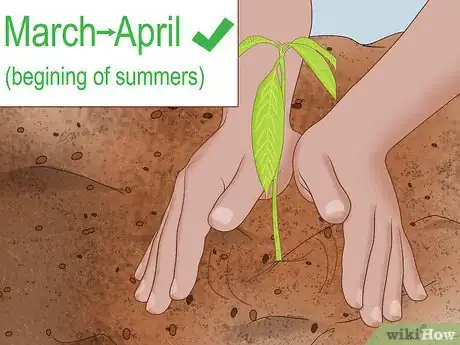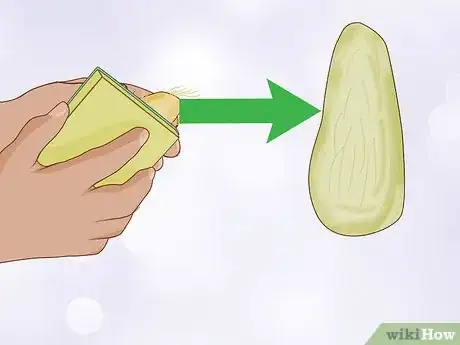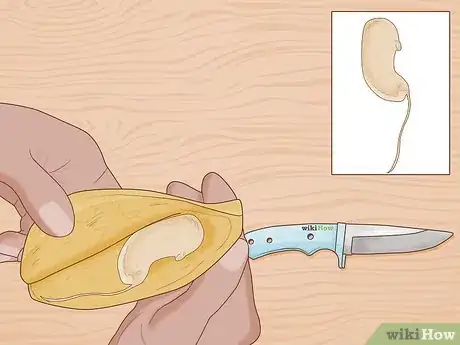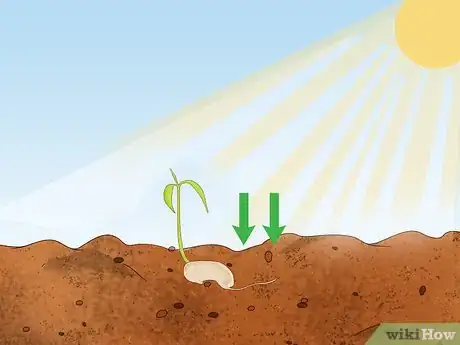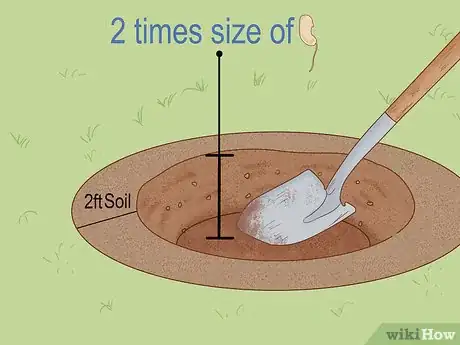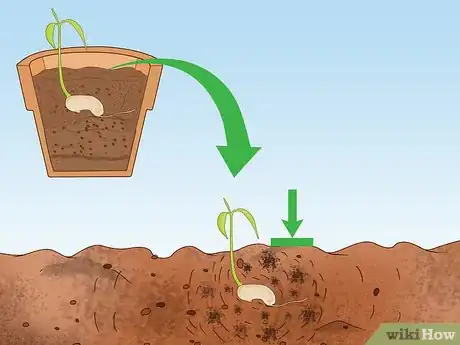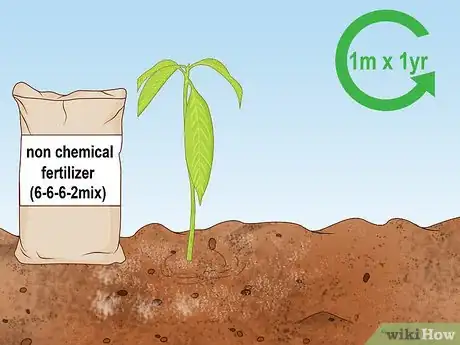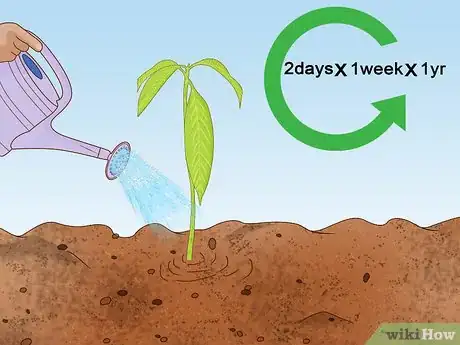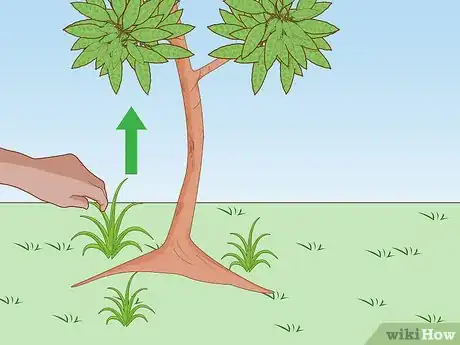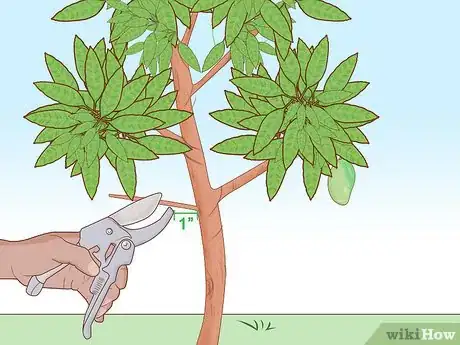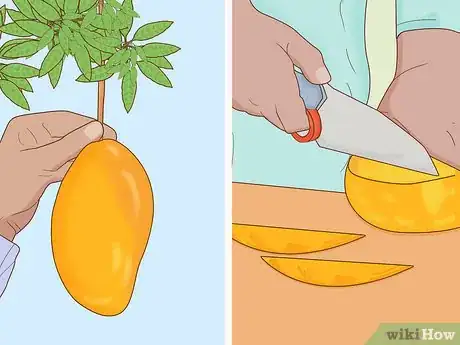This article was co-authored by Andrew Carberry, MPH. Andrew Carberry is a Food Systems Expert and the Senior Program Associate at the Wallace Centere at Winrock International in Little Rock, Arkansas. He has worked in food systems since 2008 and has experience working on farm-to-school projects, food safety programs, and working with local and state coalitions in Arkansas. He is a graduate of the College of William and Mary and holds a Masters degree in public health and nutrition from the University of Tennessee.
There are 7 references cited in this article, which can be found at the bottom of the page.
wikiHow marks an article as reader-approved once it receives enough positive feedback. This article received 14 testimonials and 100% of readers who voted found it helpful, earning it our reader-approved status.
This article has been viewed 636,420 times.
If you live in a climate that is favorable to mango plants, you can plant and grow your own mango tree and enjoy the sweet, vitamin-packed tropical fruit for years on end. With time and patience (it takes about eight years to grow a mango tree), it is quite easy to grow a mango tree from seed or from a small plant.
Steps
Preparing for Planting
-
1Determine if you have a suitable environment. Although mangoes don’t require much maintenance once planted, they do have particular circumstances under which they must grow. Mangoes thrive best in high heat, and can handle both humid/swampy or arid areas. Most mangoes are grown near the equator, and in the United States they are primarily grown in Florida. If you live in an area that has average temperatures of 80–100 °F (27–38 °C) and cool winters that don’t freeze, you’ll likely be able to grow mangoes.
- Rainfall for your area should not exceed 12 inches (30.5 cm) per year.
-
2Select an area to grow your mango tree. Mangoes can be grown in pots or in spacious areas outside. They prefer lots of heat and direct sunlight, meaning that they don’t grow well indoors (although they can be brought in a pot for the winter). The size of each mango tree varies depending on what species it is, but they can get quite large, exceeding heights of 10–15 feet (3.0–4.6 m). Therefore, choose an area that will give your tree plenty of space to thrive without being shaded by other larger trees.Advertisement
-
3Choose a variety of mango to plant. There are many different types of mangoes on the market, but only a few grow well in specific areas. Visit a local nursery to find out which ones grow best in your area. Mangoes can be grown in one of two ways: via the seed of a mango, or from a grafted sapling. Mango seeds typically take eight years to produce fruit. Grafted saplings take three to five years to produce fruit and are nearly guaranteed a good harvest. If you choose to plant from a seed, choose a mango from a tree you know grows successfully in your area; taking one from a store-bought mango probably won’t provide you with a tree.[1]
- Grafted saplings will only reach about half the size of a tree grown from seed.
- The trees produced from seeds tend to be much stronger and hardier, but they may not be as reliable when it comes to fruit-bearing.
- If you’re testing the environmental limits with your mango growing, there are a few species that are able to grow in slightly cooler and wetter conditions than the aforementioned recommendation.
-
4Get your soil ready. Mangoes thrive in loose, sandy soil that drains water easily. Check the pH of your soil to see if it is in an adequate acidity range; the trees will grow best in soil that has a pH of 4.5 – 7 (acidic). Incorporate peat moss into your soil on a yearly basis in order to keep the acidity high. Avoid using chemical fertilizers or any product that contains salt, as these will hinder the growth of your mango tree. Prepare the soil so that it is tilled about three feet deep, as this will give plenty of space for the roots to spread.[2]
-
5Know when to plant. Mango trees should typically be planted in late spring or the beginning of summer when it is a combination of rainy/sunny weather. The planting season will depend on the species, so check your local nursery to find out when yours should be planted. Some varieties, such as the Beverly and Keitt don’t need to be planted until August/September.[3]
Growing a Tree from a Seed
-
1Select a large, ripe polyembryonic mango. If you live in an area that grows mangoes, visit local orchards to select a fruit. If you don’t have access to a healthy mango tree, visit a local grocer or farmer's market to select a fruit. Ask the salesperson for help in choosing a fruit that is polyembryonic.[4]
- Polyembryonic seeds will produce clones of the parent tree. A polyembryonic seed should come from the fruit of a tree that thrives in your area. This way, you have a good idea of exactly the type of fruit you are getting — it should taste identical to the fruit of the parent tree.[5]
-
2Remove and clean the pit. Eat the mango, or remove all existing fruit, until the fibrous pit is exposed. Clean the pit with a scrub brush, or steel wool pad, until all hairs have been removed. Be careful not to scrub away at the outer coating of the pit, and only to remove the fruit fibers that are still attached.
-
3Prepare the pit for planting. Dry the pit overnight in a cool location away from direct sunlight. Open the pit with a sharp knife, as you would shuck an oyster, being careful not to cut too deeply and damage the enclosed seed. Pry the pit open and remove the seed, which resembles a large lima bean.
-
4Germinate the seed. Place the seed about an inch deep, and concave side down, in a container full of quality potting soil. Dampen the soil and store the container in a warm, shaded area until the seed sprouts. This process usually takes one to three weeks.[6]
-
5Plant the seed. At this point, your seed is ready to be planted in its permanent location. If you plan to have it outside, try to plant it directly outside rather than putting it in a plant and transplanting it, as that way you won’t have to worry about hardening it off or it going into soil shock.
Planting the Mango Tree
-
1Dig the hole for planting. In your selected plot location, use a shovel to dig a hole that is two to four times the size of the rootball of your mango plant. If you’re planting in area that already has grass, remove the grass in an area a further 2 feet (0.6 m) around the plot space to make room for the tree. Mix a bit of compost (no more than a 50/50 mixture) with the soil you’ve dug up which will be replaced around the roots.
-
2Plant the tree. Remove the sapling from the container or place your seed in the hole. The base of the tree/sprout should be level with or slightly above the ground. Replace the soil you’ve dug out by filling in the hole around the tree and lightly tamping it. Mango trees grow best in loose soil, so avoid applying too much pressure to the plot as you refill the hole.[7]
-
3Fertilize the tree. Wait until you see some growth from the tree before you begin fertilizing the tree. After that, you can fertilize your mango tree once a month for the first year. Use a non-chemical fertilizer — a fertilizer with a 6-6-6-2 mix should be good. You can dissolve the fertilizer in a bit of warm water for application, and keep the solution on hand for your monthly use.
-
4Water your mango tree. Mango trees don’t like a ton of water, but the first week watering should be slightly above average. Water the new tree every other day for the first week, and then water it only once or twice a week for the first year.[8]
- If there are five or more days of little to no rainfall, then you should water your young mango tree (under 3 years old) once a week until the dry period ends.
-
5Keep weeds at bay. Weeds can become a serious problem around your mango trees if not dealt with on a regular basis. Make sure to weed regularly, removing any plants that sprout up near the trunk of the tree. Add a thick layer of mulch around the tree to help trap in moisture and prevent weed growth as well. You can add a bit of compost to the mulch as well to help supply the tree with added nutrients.
-
6Prune your tree when necessary. The goal of pruning is to allow for as much space for branches to form, as the fruit will develop at the end of the branches (known as terminal flowers). Cut branches 1 inch (2.5 cm) from the trunk if there is too much crowding near the center, typically after the last fruit of the season (in the fall). You can prune your tree to limit its outward growth as well, by simply cutting off branches that are too tall or wide. If you have questions about your specific mango tree, visit a local nursery and check in for tips there.
-
7Harvest your mangoes. Because mangoes vary in color, shape, and size from species to species, you can’t tell if the fruit is ripe until you cut it open. You can get a general sense depending on how soft and fragrant it is, but should use a knife to sample the fruit. When the meat is yellow through to the core, it is ready to eat. If it is still very white and hard, then wait one to two weeks before testing it again. If you do pick your fruit early, you can ripen it by keeping it in a paper bag in room temperature for a few days. A nice alternative if you have picked them early is to make a salad by julienning them and making a green mango salad that goes well with fish dishes. [9]
Expert Q&A
Did you know you can get expert answers for this article?
Unlock expert answers by supporting wikiHow
-
QuestionHow far from walls should the trees be planted?
 Andrew Carberry, MPHAndrew Carberry is a Food Systems Expert and the Senior Program Associate at the Wallace Centere at Winrock International in Little Rock, Arkansas. He has worked in food systems since 2008 and has experience working on farm-to-school projects, food safety programs, and working with local and state coalitions in Arkansas. He is a graduate of the College of William and Mary and holds a Masters degree in public health and nutrition from the University of Tennessee.
Andrew Carberry, MPHAndrew Carberry is a Food Systems Expert and the Senior Program Associate at the Wallace Centere at Winrock International in Little Rock, Arkansas. He has worked in food systems since 2008 and has experience working on farm-to-school projects, food safety programs, and working with local and state coalitions in Arkansas. He is a graduate of the College of William and Mary and holds a Masters degree in public health and nutrition from the University of Tennessee.
Food Systems Expert
-
QuestionHow far apart should mango trees be planted?
 Andrew Carberry, MPHAndrew Carberry is a Food Systems Expert and the Senior Program Associate at the Wallace Centere at Winrock International in Little Rock, Arkansas. He has worked in food systems since 2008 and has experience working on farm-to-school projects, food safety programs, and working with local and state coalitions in Arkansas. He is a graduate of the College of William and Mary and holds a Masters degree in public health and nutrition from the University of Tennessee.
Andrew Carberry, MPHAndrew Carberry is a Food Systems Expert and the Senior Program Associate at the Wallace Centere at Winrock International in Little Rock, Arkansas. He has worked in food systems since 2008 and has experience working on farm-to-school projects, food safety programs, and working with local and state coalitions in Arkansas. He is a graduate of the College of William and Mary and holds a Masters degree in public health and nutrition from the University of Tennessee.
Food Systems Expert
-
QuestionHow much time does the mango tree take to grow fruit?
 Community AnswerIf you are growing it from seed, it usually needs 5 to 8 years. If you bought the plant from nursery, it will need 3 to 4 years.
Community AnswerIf you are growing it from seed, it usually needs 5 to 8 years. If you bought the plant from nursery, it will need 3 to 4 years.
Warnings
- Anthracnose fungus is deadly to mango trees because it attacks all parts of the tree. Apply fungicides at the first sign of black-spotted fruit.⧼thumbs_response⧽
References
- ↑ http://www.tropicalpermaculture.com/growing-mangoes.html
- ↑ http://homeguides.sfgate.com/soil-mango-tree-58272.html
- ↑ http://www.tropicamango.com/mangos.html
- ↑ http://www.tropicalpermaculture.com/growing-mangoes.html
- ↑ https://www.agric.wa.gov.au/mangoes/propagating-mangoes
- ↑ http://aggie-horticulture.tamu.edu/
- ↑ http://edis.ifas.ufl.edu/mg216
- ↑ http://edis.ifas.ufl.edu/mg216
- ↑ http://www.nda.agric.za/docs/Infopaks/mango.htm
About This Article
Mango trees are easy to grow if you live in the right climate. Mangoes thrive in areas where the average temperature stays between 80–100 °F (27–38 °C) during most of the year and does not dip below freezing in the winter. It’s also best if you don’t get more than 12 inches (30.5 cm) of rain per year. Your mango will be happiest outdoors in an area that gets plenty of direct sunlight during the day, with sandy, well-drained, acidic soil. To grow a mango tree from seed, remove the pit from a large, ripe mango fruit and clean it with a scrub brush or steel wool pad to remove all the fibers. Put the pit someplace cool and dark and allow it to dry overnight, then carefully pry it open with a sharp knife and remove the inner seed. Place the seed about 1 inch (2.5 cm) deep in a pot full of potting soil, making sure to position the seed with the concave side facing down. Dampen the soil, but don’t make it sopping wet. Store the pot in a warm, shady area for about 2-3 weeks, or until the seed sprouts. Once you see a sprout, transfer the seedling to the ground or a larger pot in a sunny location outdoors. If you’re planting a larger sapling, dig a hole that’s about 2 to 4 times the size of the baby tree’s root ball. Set the tree in the hole so that the root ball is level with the ground or slightly above it, then fill in the hole with a 50:50 mix of compost and soil. After you’ve planted the tree, wait until you see some new growth, then dissolve some 6-6-6-2 fertilizer in warm water and apply it around the base of the tree. From then on, fertilize the tree about once a month during its first year. Water your mango tree every other day for the first week after you plant it, then about once or twice a week for the rest of its first year. You can also water older trees once a week if you’re having a particularly dry period. Weed the area around the base of the tree regularly, and put a layer of mulch around the roots to trap moisture and prevent new weeds from growing. As the tree gets bigger, prune it occasionally to reduce crowding near the center of the tree and encourage it to grow new fruit. Cut excess branches back to about 1 inch (2.5 cm) from the trunk. After about 5 to 8 years, your mango tree will begin to produce fruit. For more tips from our Gardener reviewer, including how to prepare your garden for planting, read on!


